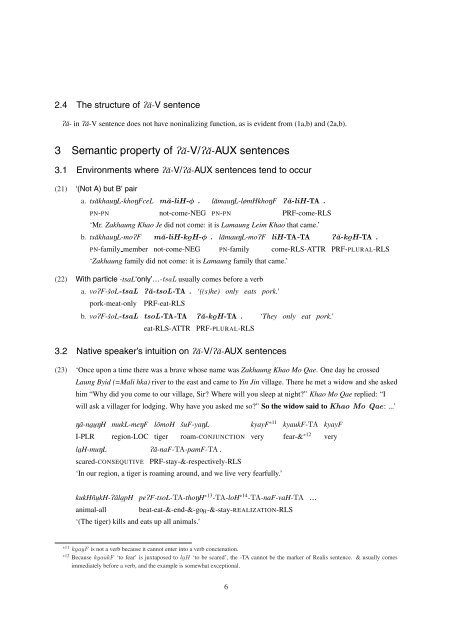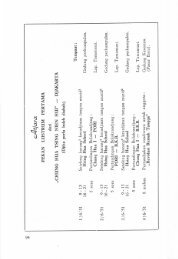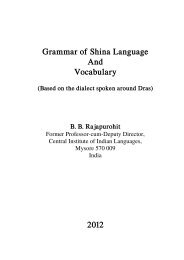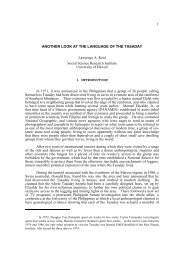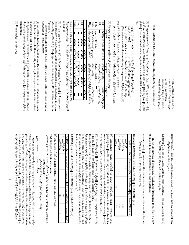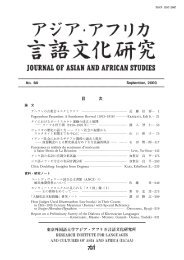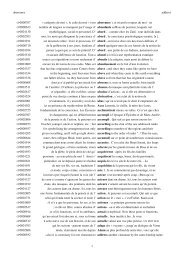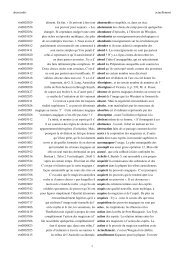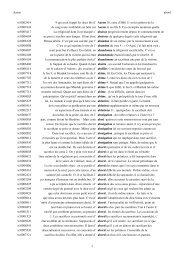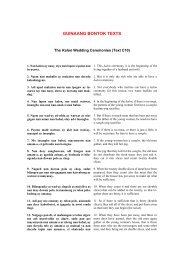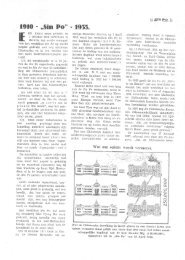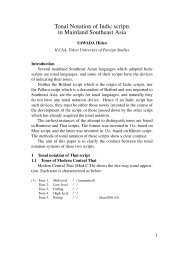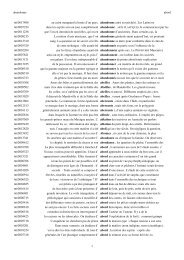PËa-prefixation on verbs and auxiliaries in Lhaovo (Maru) Language ...
PËa-prefixation on verbs and auxiliaries in Lhaovo (Maru) Language ...
PËa-prefixation on verbs and auxiliaries in Lhaovo (Maru) Language ...
You also want an ePaper? Increase the reach of your titles
YUMPU automatically turns print PDFs into web optimized ePapers that Google loves.
2.4 The structure of Pă-V sentence<br />
Pă- <strong>in</strong> Pă-V sentence does not have n<strong>on</strong><strong>in</strong>aliz<strong>in</strong>g functi<strong>on</strong>, as is evident from (1a,b) <strong>and</strong> (2a,b).<br />
3 Semantic property of Pă-V/Pă-AUX sentences<br />
3.1 Envir<strong>on</strong>ments where Pă-V/Pă-AUX sentences tend to occur<br />
(21) ‘(Not A) but B’ pair<br />
a. tsăkhauNL-khoNFceL<br />
PN-PN<br />
mă-liH-φ .<br />
not-come-NEG<br />
lămauNL-lømHkhoNF<br />
PN-PN<br />
Pă-liH-TA .<br />
PRF-come-RLS<br />
‘Mr. Zakhaung Khao Je did not come: it is Lamaung Leim Khao that came.’<br />
b. tsăkhauNL-moPF<br />
PN-family member<br />
mă-liH-kōH-φ .<br />
not-come-NEG<br />
lămauNL-moPF<br />
PN-family<br />
liH-TA-TA<br />
come-RLS-ATTR<br />
Pă-kōH-TA .<br />
PRF-PLURAL-RLS<br />
‘Zakhaung family did not come: it is Lamaung family that came.’<br />
(22) With particle -tsaL‘<strong>on</strong>ly’-tsaL usually comes before a verb<br />
a. voPF-šoL-tsaL Pă-tsoL-TA . ‘((s)he) <strong>on</strong>ly eats pork.’<br />
pork-meat-<strong>on</strong>ly PRF-eat-RLS<br />
b. voPF-šoL-tsaL tsoL-TA-TA Pă-kōH-TA . ‘They <strong>on</strong>ly eat pork.’<br />
eat-RLS-ATTR PRF-PLURAL-RLS<br />
3.2 Native speaker’s <strong>in</strong>tuiti<strong>on</strong> <strong>on</strong> Pă-V/Pă-AUX sentences<br />
(23) ‘Once up<strong>on</strong> a time there was a brave whose name was Zakhaung Khao Mo Qae. One day he crossed<br />
Laung Byid (=Mali hka) river to the east <strong>and</strong> came to Y<strong>in</strong> J<strong>in</strong> village. There he met a widow <strong>and</strong> she asked<br />
him “Why did you come to our village, Sir Where will you sleep at night” Khao Mo Qae replied: “I<br />
will ask a villager for lodg<strong>in</strong>g. Why have you asked me so” So the widow said to Khao Mo Qae: ...’<br />
Nă-nāūNH<br />
I-PLR<br />
lāH-muNL<br />
mukL-meNF lŏmoH<br />
regi<strong>on</strong>-LOC tiger<br />
šuF-yaNL<br />
kyayF * 11<br />
roam-CONJUNCTION very<br />
Pă-naF-TA-pamF-TA .<br />
scared-CONSEQUTIVE PRF-stay-&-respectively-RLS<br />
‘In our regi<strong>on</strong>, a tiger is roam<strong>in</strong>g around, <strong>and</strong> we live very fearfully.’<br />
kyaukF-TA<br />
fear-& * 12<br />
kyayF<br />
very<br />
kukHñūkH-PălāpH pePF-tsoL-TA-thoNH * 13 -TA-loH * 14 -TA-naF-vaH-TA<br />
animal-all beat-eat-&-end-&-go H -&-stay-REALIZATION-RLS<br />
‘(The tiger) kills <strong>and</strong> eats up all animals.’<br />
<br />
*11 kyayF is not a verb because it cannot enter <strong>in</strong>to a verb c<strong>on</strong>ctenati<strong>on</strong>.<br />
*12 Because kyaukF ‘to fear’ is juxtaposed to lāH ‘to be scared’, the -TA cannot be the marker of Realis sentence. & usually comes<br />
immediately before a verb, <strong>and</strong> the example is somewhat excepti<strong>on</strong>al.<br />
6


